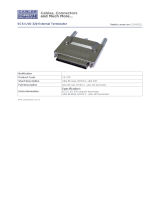
ii
Copyright © 2003-2008 by LSI Corporation. All rights reserved.
LSI products are not intended for use in life-support appliances, devices, or
systems. Use of any LSI product in such applications without written consent of
the appropriate LSI officer is prohibited.
Purchase of I
2
C components of LSI Corporation, or one of its sublicensed
Associated Companies, conveys a license under the Philips I
2
C Patent Rights to
use these components in an I
2
C system, provided that the system conforms to
the I
2
C standard Specification as defined by Philips.
Document 80-00143-01 Rev. B, March 2008. This document describes the
current version of the LSI Corporation MegaRAID 320 Storage Adapters and will
remain the official reference source for all revisions/releases of these products
until rescinded by an update.
LSI Corporation reserves the right to make changes to any products herein at
any time without notice. LSI does not assume any responsibility or liability arising
out of the application or use of any product described herein, except as expressly
agreed to in writing by LSI; nor does the purchase or use of a product from LSI
convey a license under any patent rights, copyrights, trademark rights, or any
other of the intellectual property rights of LSI or third parties.
Copyright © 2003-2008 by LSI Corporation. All rights reserved.
TRADEMARK ACKNOWLEDGMENT
LSI, the LSI logo design, Fusion-MPT, and MegaRAID are trademarks or
registered trademarks of LSI Corporation. Microsoft, Windows, and Windows NT
are registered trademarks of Microsoft Corporation. Novell and NetWare are
registered trademarks of Novell Corporation. UNIX and UnixWare are registered
trademarks of The Open Group. SCO is a registered trademark of Caldera
International, Inc. Linux is a registered trademark of Linus Torvalds. PCI-X is a
registered trademark of PCI SIG. All other brand and product names may be
trademarks of their respective companies.
CD
To receive product literature, visit us at http://www.lsi.com.
For a current list of our distributors, sales offices, and design resource
centers, view our web page located at
http://www.lsi.com/contacts/index.html






















